ICON College - Unit 12: Organizational Behaviour Report & Analysis
VerifiedAdded on 2022/12/27
|16
|4982
|59
Report
AI Summary
This report provides a comprehensive analysis of organizational behaviour, focusing on the case study of Marks and Spencer. It delves into the influence of culture, politics, and power on individual and group behaviour within the company, utilizing Handy's model of culture and French and Raven's model of power to illustrate key concepts. The report evaluates content and process theories of motivation, specifically Maslow's hierarchy of needs and Vroom's expectancy theory, and examines motivational techniques employed by Marks and Spencer to achieve organizational goals. Furthermore, it differentiates between effective and ineffective teams, highlighting their characteristics in the context of the company. The report also covers organizational theory and concepts, providing a holistic understanding of organizational behaviour principles. The analysis is designed to provide practical examples and insights into organizational behaviour within a real-world business context.
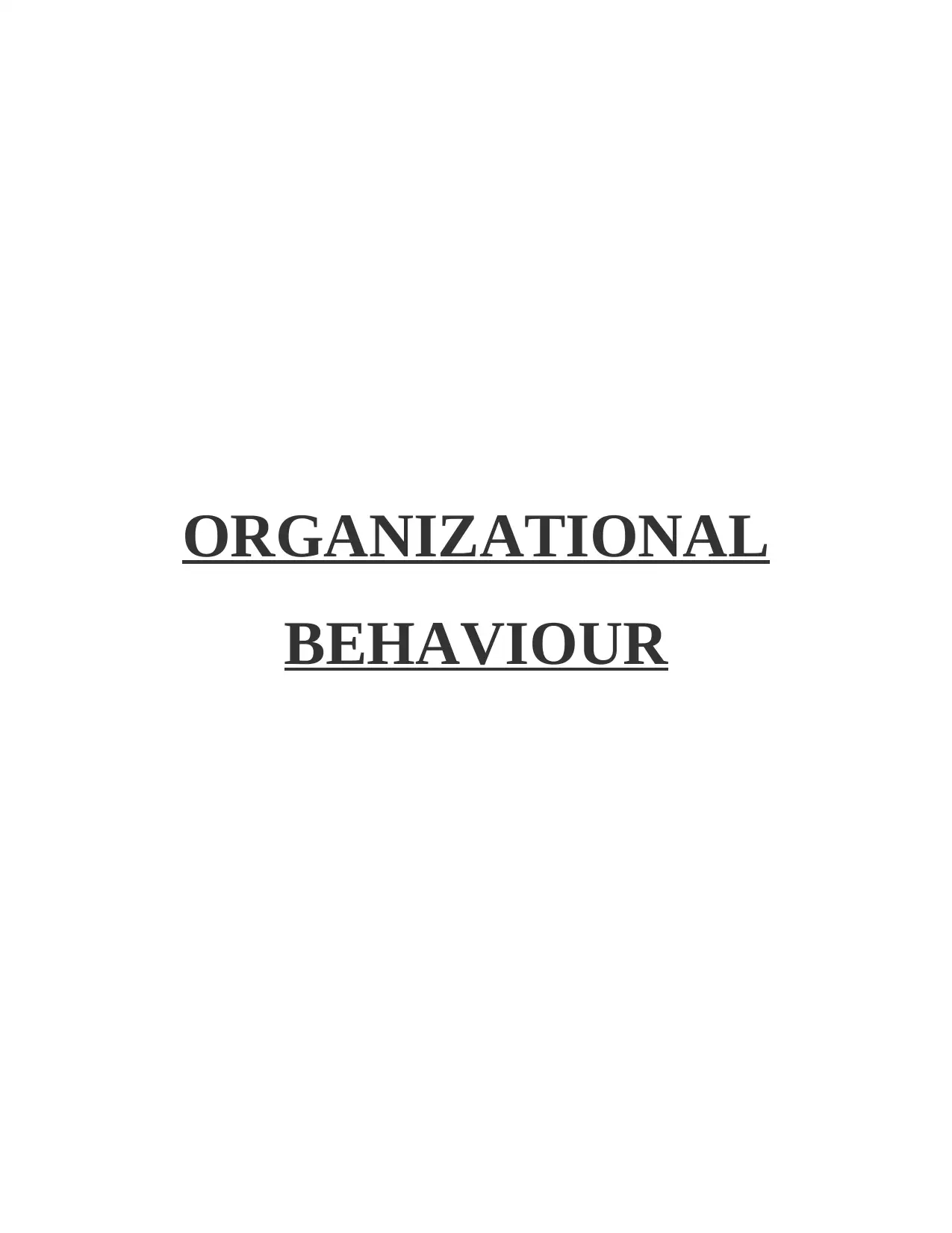
ORGANIZATIONAL
BEHAVIOUR
BEHAVIOUR
Paraphrase This Document
Need a fresh take? Get an instant paraphrase of this document with our AI Paraphraser
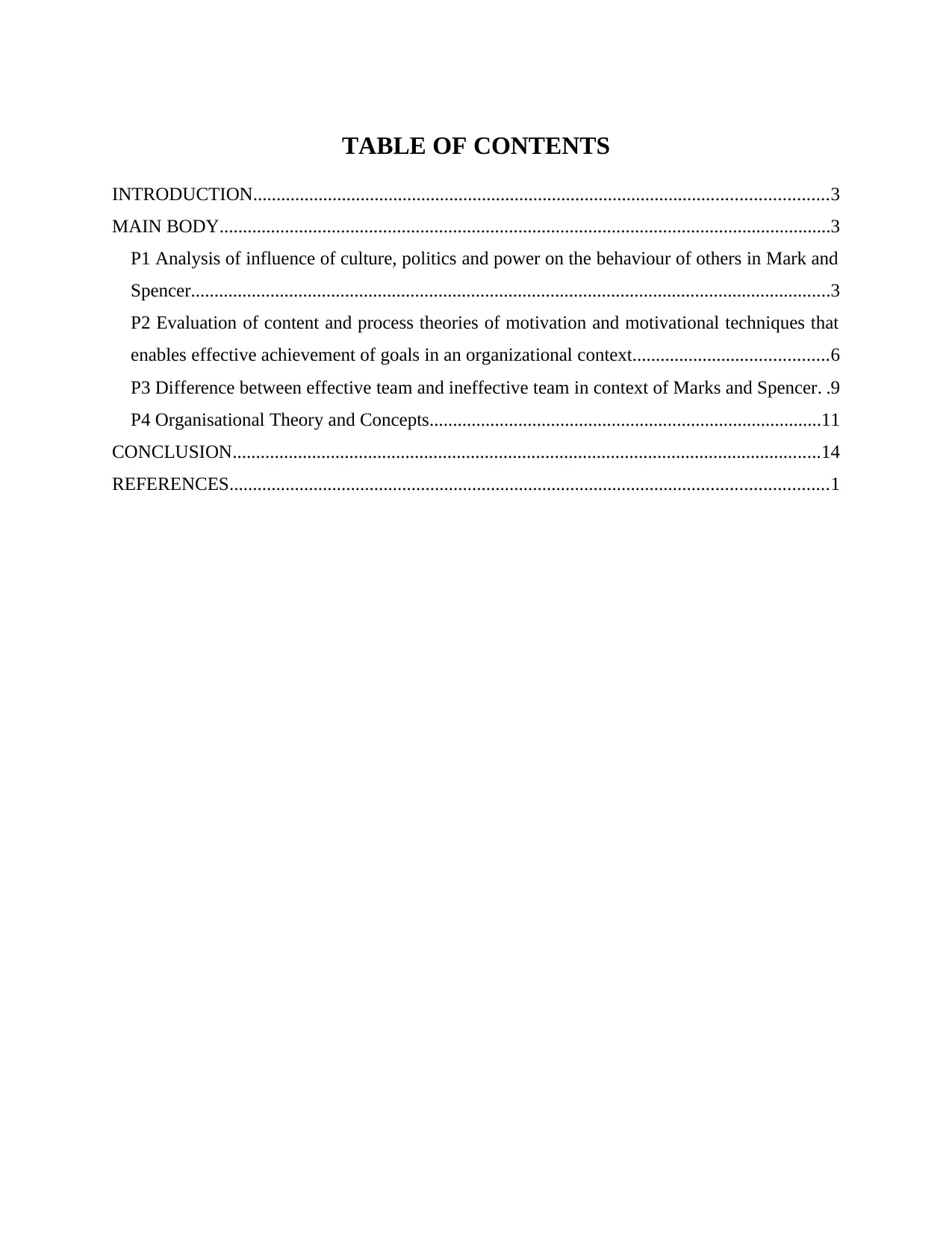
TABLE OF CONTENTS
INTRODUCTION...........................................................................................................................3
MAIN BODY...................................................................................................................................3
P1 Analysis of influence of culture, politics and power on the behaviour of others in Mark and
Spencer.........................................................................................................................................3
P2 Evaluation of content and process theories of motivation and motivational techniques that
enables effective achievement of goals in an organizational context..........................................6
P3 Difference between effective team and ineffective team in context of Marks and Spencer. .9
P4 Organisational Theory and Concepts....................................................................................11
CONCLUSION..............................................................................................................................14
REFERENCES................................................................................................................................1
INTRODUCTION...........................................................................................................................3
MAIN BODY...................................................................................................................................3
P1 Analysis of influence of culture, politics and power on the behaviour of others in Mark and
Spencer.........................................................................................................................................3
P2 Evaluation of content and process theories of motivation and motivational techniques that
enables effective achievement of goals in an organizational context..........................................6
P3 Difference between effective team and ineffective team in context of Marks and Spencer. .9
P4 Organisational Theory and Concepts....................................................................................11
CONCLUSION..............................................................................................................................14
REFERENCES................................................................................................................................1
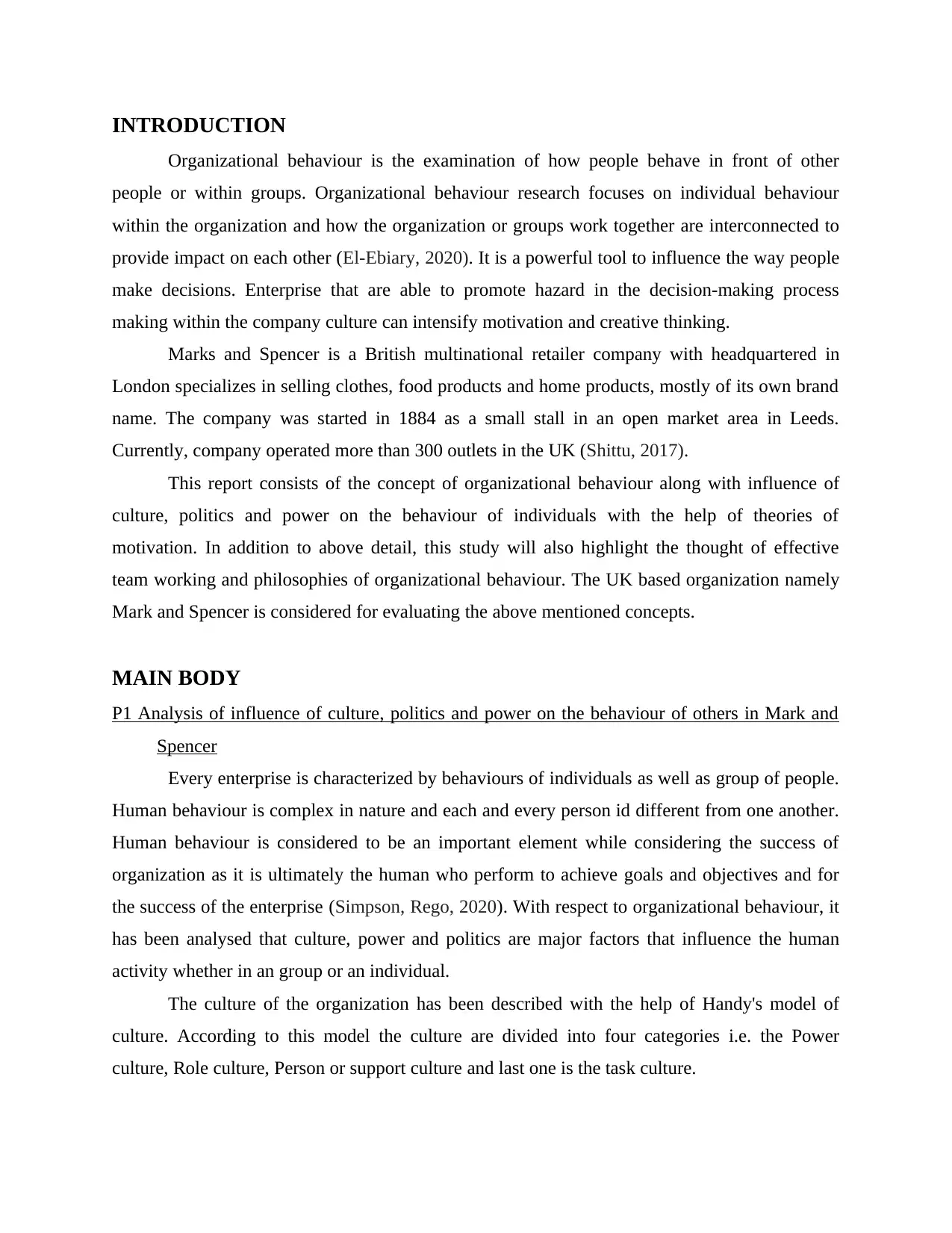
INTRODUCTION
Organizational behaviour is the examination of how people behave in front of other
people or within groups. Organizational behaviour research focuses on individual behaviour
within the organization and how the organization or groups work together are interconnected to
provide impact on each other (El-Ebiary, 2020). It is a powerful tool to influence the way people
make decisions. Enterprise that are able to promote hazard in the decision-making process
making within the company culture can intensify motivation and creative thinking.
Marks and Spencer is a British multinational retailer company with headquartered in
London specializes in selling clothes, food products and home products, mostly of its own brand
name. The company was started in 1884 as a small stall in an open market area in Leeds.
Currently, company operated more than 300 outlets in the UK (Shittu, 2017).
This report consists of the concept of organizational behaviour along with influence of
culture, politics and power on the behaviour of individuals with the help of theories of
motivation. In addition to above detail, this study will also highlight the thought of effective
team working and philosophies of organizational behaviour. The UK based organization namely
Mark and Spencer is considered for evaluating the above mentioned concepts.
MAIN BODY
P1 Analysis of influence of culture, politics and power on the behaviour of others in Mark and
Spencer
Every enterprise is characterized by behaviours of individuals as well as group of people.
Human behaviour is complex in nature and each and every person id different from one another.
Human behaviour is considered to be an important element while considering the success of
organization as it is ultimately the human who perform to achieve goals and objectives and for
the success of the enterprise (Simpson, Rego, 2020). With respect to organizational behaviour, it
has been analysed that culture, power and politics are major factors that influence the human
activity whether in an group or an individual.
The culture of the organization has been described with the help of Handy's model of
culture. According to this model the culture are divided into four categories i.e. the Power
culture, Role culture, Person or support culture and last one is the task culture.
Organizational behaviour is the examination of how people behave in front of other
people or within groups. Organizational behaviour research focuses on individual behaviour
within the organization and how the organization or groups work together are interconnected to
provide impact on each other (El-Ebiary, 2020). It is a powerful tool to influence the way people
make decisions. Enterprise that are able to promote hazard in the decision-making process
making within the company culture can intensify motivation and creative thinking.
Marks and Spencer is a British multinational retailer company with headquartered in
London specializes in selling clothes, food products and home products, mostly of its own brand
name. The company was started in 1884 as a small stall in an open market area in Leeds.
Currently, company operated more than 300 outlets in the UK (Shittu, 2017).
This report consists of the concept of organizational behaviour along with influence of
culture, politics and power on the behaviour of individuals with the help of theories of
motivation. In addition to above detail, this study will also highlight the thought of effective
team working and philosophies of organizational behaviour. The UK based organization namely
Mark and Spencer is considered for evaluating the above mentioned concepts.
MAIN BODY
P1 Analysis of influence of culture, politics and power on the behaviour of others in Mark and
Spencer
Every enterprise is characterized by behaviours of individuals as well as group of people.
Human behaviour is complex in nature and each and every person id different from one another.
Human behaviour is considered to be an important element while considering the success of
organization as it is ultimately the human who perform to achieve goals and objectives and for
the success of the enterprise (Simpson, Rego, 2020). With respect to organizational behaviour, it
has been analysed that culture, power and politics are major factors that influence the human
activity whether in an group or an individual.
The culture of the organization has been described with the help of Handy's model of
culture. According to this model the culture are divided into four categories i.e. the Power
culture, Role culture, Person or support culture and last one is the task culture.
⊘ This is a preview!⊘
Do you want full access?
Subscribe today to unlock all pages.

Trusted by 1+ million students worldwide
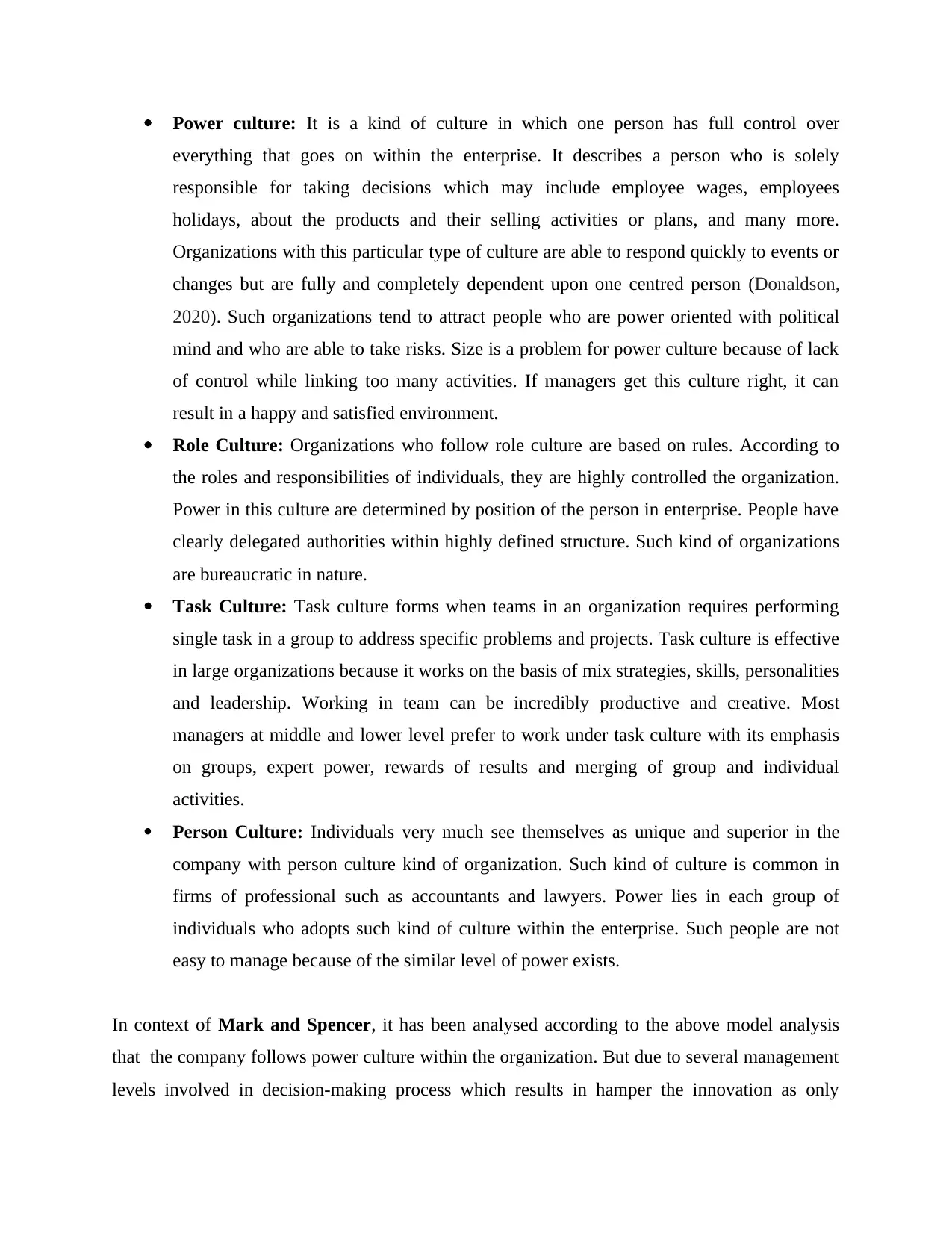
Power culture: It is a kind of culture in which one person has full control over
everything that goes on within the enterprise. It describes a person who is solely
responsible for taking decisions which may include employee wages, employees
holidays, about the products and their selling activities or plans, and many more.
Organizations with this particular type of culture are able to respond quickly to events or
changes but are fully and completely dependent upon one centred person (Donaldson,
2020). Such organizations tend to attract people who are power oriented with political
mind and who are able to take risks. Size is a problem for power culture because of lack
of control while linking too many activities. If managers get this culture right, it can
result in a happy and satisfied environment.
Role Culture: Organizations who follow role culture are based on rules. According to
the roles and responsibilities of individuals, they are highly controlled the organization.
Power in this culture are determined by position of the person in enterprise. People have
clearly delegated authorities within highly defined structure. Such kind of organizations
are bureaucratic in nature.
Task Culture: Task culture forms when teams in an organization requires performing
single task in a group to address specific problems and projects. Task culture is effective
in large organizations because it works on the basis of mix strategies, skills, personalities
and leadership. Working in team can be incredibly productive and creative. Most
managers at middle and lower level prefer to work under task culture with its emphasis
on groups, expert power, rewards of results and merging of group and individual
activities.
Person Culture: Individuals very much see themselves as unique and superior in the
company with person culture kind of organization. Such kind of culture is common in
firms of professional such as accountants and lawyers. Power lies in each group of
individuals who adopts such kind of culture within the enterprise. Such people are not
easy to manage because of the similar level of power exists.
In context of Mark and Spencer, it has been analysed according to the above model analysis
that the company follows power culture within the organization. But due to several management
levels involved in decision-making process which results in hamper the innovation as only
everything that goes on within the enterprise. It describes a person who is solely
responsible for taking decisions which may include employee wages, employees
holidays, about the products and their selling activities or plans, and many more.
Organizations with this particular type of culture are able to respond quickly to events or
changes but are fully and completely dependent upon one centred person (Donaldson,
2020). Such organizations tend to attract people who are power oriented with political
mind and who are able to take risks. Size is a problem for power culture because of lack
of control while linking too many activities. If managers get this culture right, it can
result in a happy and satisfied environment.
Role Culture: Organizations who follow role culture are based on rules. According to
the roles and responsibilities of individuals, they are highly controlled the organization.
Power in this culture are determined by position of the person in enterprise. People have
clearly delegated authorities within highly defined structure. Such kind of organizations
are bureaucratic in nature.
Task Culture: Task culture forms when teams in an organization requires performing
single task in a group to address specific problems and projects. Task culture is effective
in large organizations because it works on the basis of mix strategies, skills, personalities
and leadership. Working in team can be incredibly productive and creative. Most
managers at middle and lower level prefer to work under task culture with its emphasis
on groups, expert power, rewards of results and merging of group and individual
activities.
Person Culture: Individuals very much see themselves as unique and superior in the
company with person culture kind of organization. Such kind of culture is common in
firms of professional such as accountants and lawyers. Power lies in each group of
individuals who adopts such kind of culture within the enterprise. Such people are not
easy to manage because of the similar level of power exists.
In context of Mark and Spencer, it has been analysed according to the above model analysis
that the company follows power culture within the organization. But due to several management
levels involved in decision-making process which results in hamper the innovation as only
Paraphrase This Document
Need a fresh take? Get an instant paraphrase of this document with our AI Paraphraser
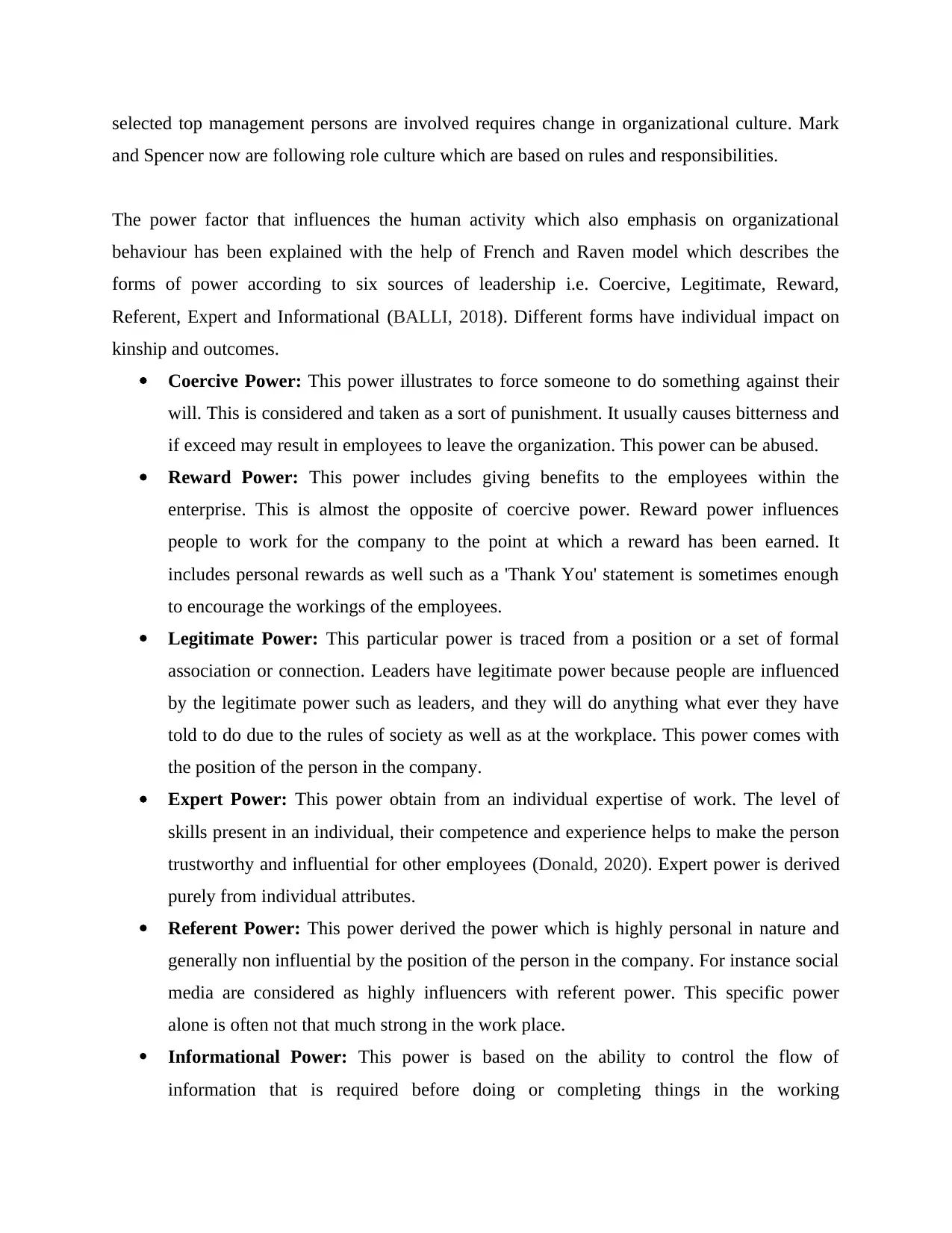
selected top management persons are involved requires change in organizational culture. Mark
and Spencer now are following role culture which are based on rules and responsibilities.
The power factor that influences the human activity which also emphasis on organizational
behaviour has been explained with the help of French and Raven model which describes the
forms of power according to six sources of leadership i.e. Coercive, Legitimate, Reward,
Referent, Expert and Informational (BALLI, 2018). Different forms have individual impact on
kinship and outcomes.
Coercive Power: This power illustrates to force someone to do something against their
will. This is considered and taken as a sort of punishment. It usually causes bitterness and
if exceed may result in employees to leave the organization. This power can be abused.
Reward Power: This power includes giving benefits to the employees within the
enterprise. This is almost the opposite of coercive power. Reward power influences
people to work for the company to the point at which a reward has been earned. It
includes personal rewards as well such as a 'Thank You' statement is sometimes enough
to encourage the workings of the employees.
Legitimate Power: This particular power is traced from a position or a set of formal
association or connection. Leaders have legitimate power because people are influenced
by the legitimate power such as leaders, and they will do anything what ever they have
told to do due to the rules of society as well as at the workplace. This power comes with
the position of the person in the company.
Expert Power: This power obtain from an individual expertise of work. The level of
skills present in an individual, their competence and experience helps to make the person
trustworthy and influential for other employees (Donald, 2020). Expert power is derived
purely from individual attributes.
Referent Power: This power derived the power which is highly personal in nature and
generally non influential by the position of the person in the company. For instance social
media are considered as highly influencers with referent power. This specific power
alone is often not that much strong in the work place.
Informational Power: This power is based on the ability to control the flow of
information that is required before doing or completing things in the working
and Spencer now are following role culture which are based on rules and responsibilities.
The power factor that influences the human activity which also emphasis on organizational
behaviour has been explained with the help of French and Raven model which describes the
forms of power according to six sources of leadership i.e. Coercive, Legitimate, Reward,
Referent, Expert and Informational (BALLI, 2018). Different forms have individual impact on
kinship and outcomes.
Coercive Power: This power illustrates to force someone to do something against their
will. This is considered and taken as a sort of punishment. It usually causes bitterness and
if exceed may result in employees to leave the organization. This power can be abused.
Reward Power: This power includes giving benefits to the employees within the
enterprise. This is almost the opposite of coercive power. Reward power influences
people to work for the company to the point at which a reward has been earned. It
includes personal rewards as well such as a 'Thank You' statement is sometimes enough
to encourage the workings of the employees.
Legitimate Power: This particular power is traced from a position or a set of formal
association or connection. Leaders have legitimate power because people are influenced
by the legitimate power such as leaders, and they will do anything what ever they have
told to do due to the rules of society as well as at the workplace. This power comes with
the position of the person in the company.
Expert Power: This power obtain from an individual expertise of work. The level of
skills present in an individual, their competence and experience helps to make the person
trustworthy and influential for other employees (Donald, 2020). Expert power is derived
purely from individual attributes.
Referent Power: This power derived the power which is highly personal in nature and
generally non influential by the position of the person in the company. For instance social
media are considered as highly influencers with referent power. This specific power
alone is often not that much strong in the work place.
Informational Power: This power is based on the ability to control the flow of
information that is required before doing or completing things in the working
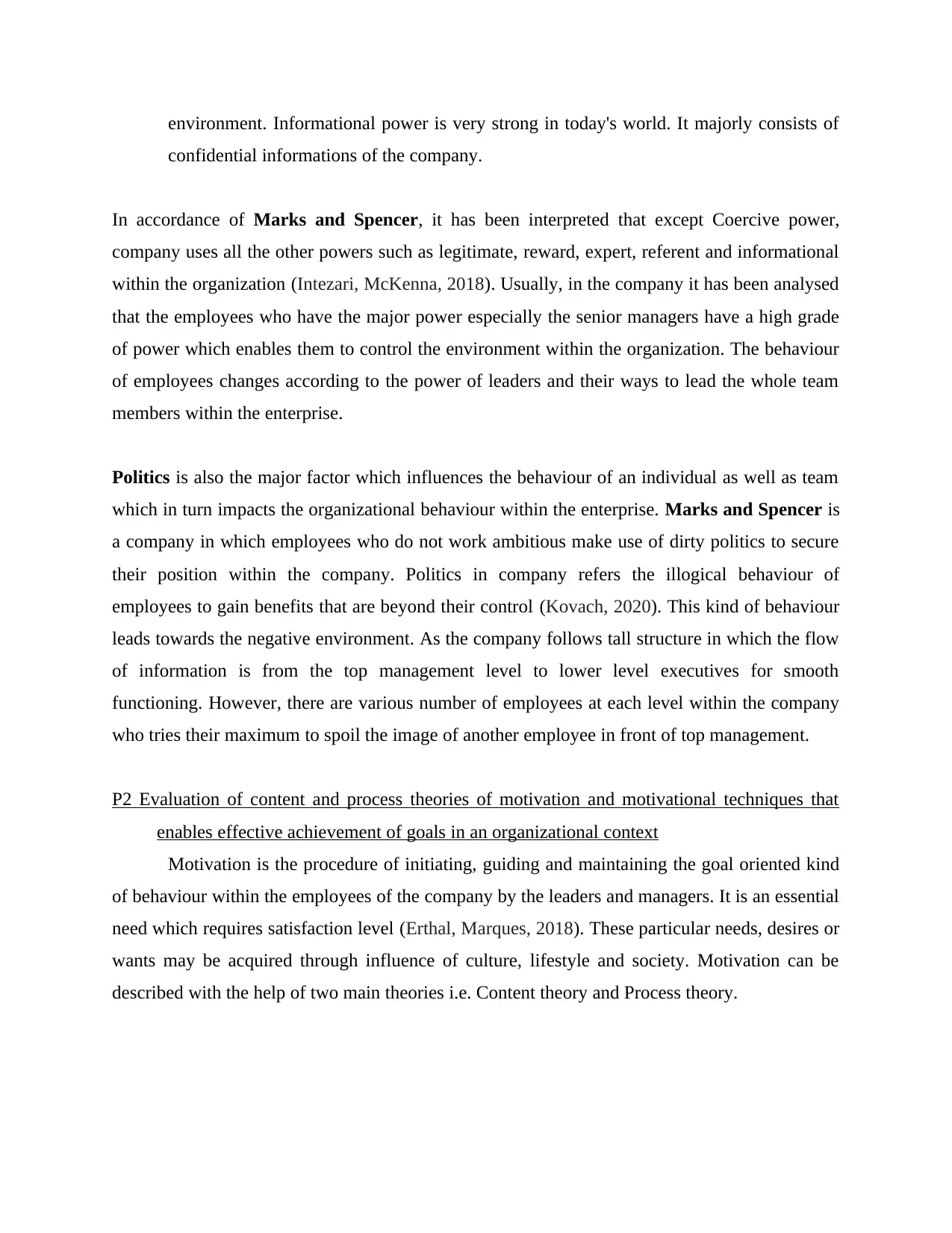
environment. Informational power is very strong in today's world. It majorly consists of
confidential informations of the company.
In accordance of Marks and Spencer, it has been interpreted that except Coercive power,
company uses all the other powers such as legitimate, reward, expert, referent and informational
within the organization (Intezari, McKenna, 2018). Usually, in the company it has been analysed
that the employees who have the major power especially the senior managers have a high grade
of power which enables them to control the environment within the organization. The behaviour
of employees changes according to the power of leaders and their ways to lead the whole team
members within the enterprise.
Politics is also the major factor which influences the behaviour of an individual as well as team
which in turn impacts the organizational behaviour within the enterprise. Marks and Spencer is
a company in which employees who do not work ambitious make use of dirty politics to secure
their position within the company. Politics in company refers the illogical behaviour of
employees to gain benefits that are beyond their control (Kovach, 2020). This kind of behaviour
leads towards the negative environment. As the company follows tall structure in which the flow
of information is from the top management level to lower level executives for smooth
functioning. However, there are various number of employees at each level within the company
who tries their maximum to spoil the image of another employee in front of top management.
P2 Evaluation of content and process theories of motivation and motivational techniques that
enables effective achievement of goals in an organizational context
Motivation is the procedure of initiating, guiding and maintaining the goal oriented kind
of behaviour within the employees of the company by the leaders and managers. It is an essential
need which requires satisfaction level (Erthal, Marques, 2018). These particular needs, desires or
wants may be acquired through influence of culture, lifestyle and society. Motivation can be
described with the help of two main theories i.e. Content theory and Process theory.
confidential informations of the company.
In accordance of Marks and Spencer, it has been interpreted that except Coercive power,
company uses all the other powers such as legitimate, reward, expert, referent and informational
within the organization (Intezari, McKenna, 2018). Usually, in the company it has been analysed
that the employees who have the major power especially the senior managers have a high grade
of power which enables them to control the environment within the organization. The behaviour
of employees changes according to the power of leaders and their ways to lead the whole team
members within the enterprise.
Politics is also the major factor which influences the behaviour of an individual as well as team
which in turn impacts the organizational behaviour within the enterprise. Marks and Spencer is
a company in which employees who do not work ambitious make use of dirty politics to secure
their position within the company. Politics in company refers the illogical behaviour of
employees to gain benefits that are beyond their control (Kovach, 2020). This kind of behaviour
leads towards the negative environment. As the company follows tall structure in which the flow
of information is from the top management level to lower level executives for smooth
functioning. However, there are various number of employees at each level within the company
who tries their maximum to spoil the image of another employee in front of top management.
P2 Evaluation of content and process theories of motivation and motivational techniques that
enables effective achievement of goals in an organizational context
Motivation is the procedure of initiating, guiding and maintaining the goal oriented kind
of behaviour within the employees of the company by the leaders and managers. It is an essential
need which requires satisfaction level (Erthal, Marques, 2018). These particular needs, desires or
wants may be acquired through influence of culture, lifestyle and society. Motivation can be
described with the help of two main theories i.e. Content theory and Process theory.
⊘ This is a preview!⊘
Do you want full access?
Subscribe today to unlock all pages.

Trusted by 1+ million students worldwide
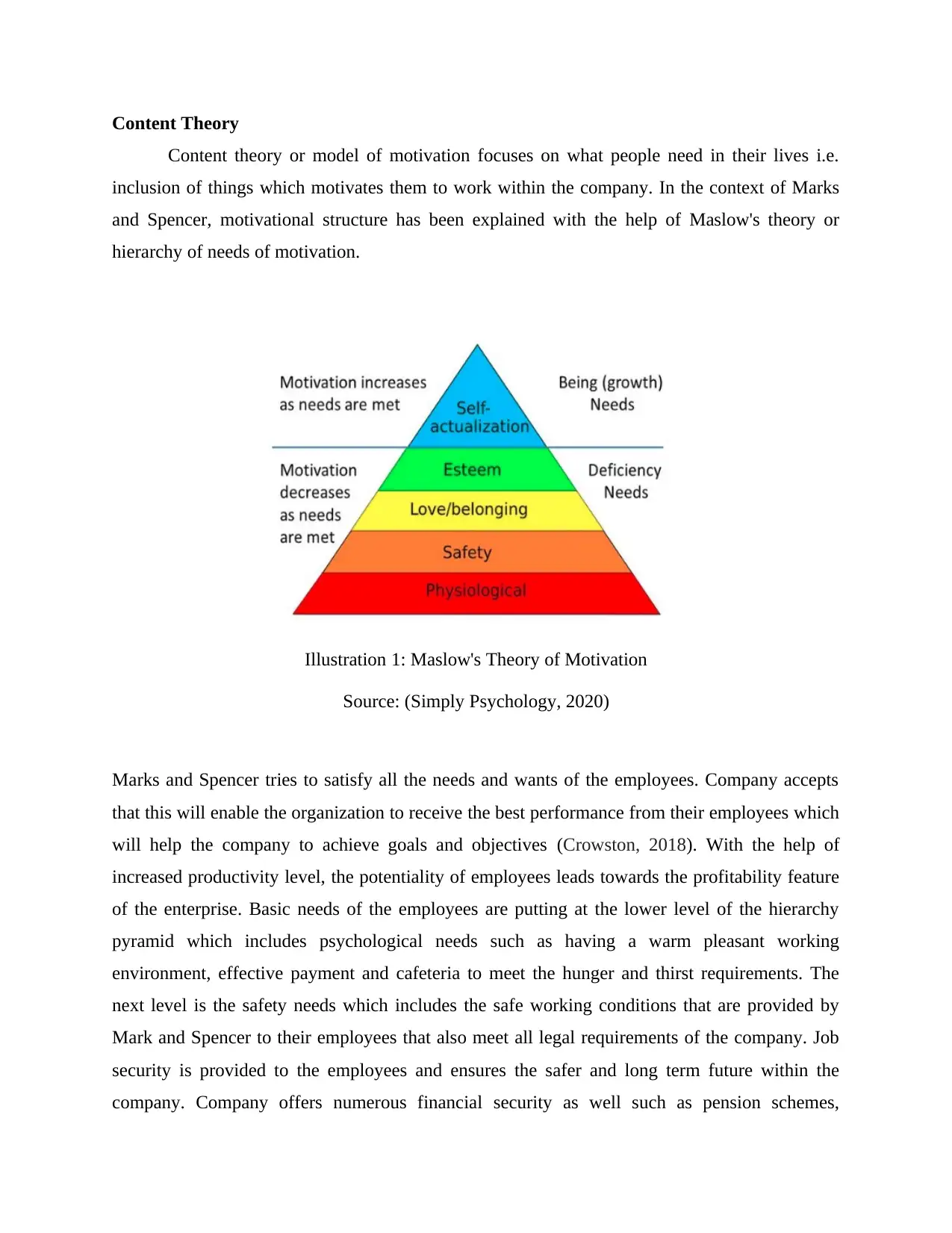
Content Theory
Content theory or model of motivation focuses on what people need in their lives i.e.
inclusion of things which motivates them to work within the company. In the context of Marks
and Spencer, motivational structure has been explained with the help of Maslow's theory or
hierarchy of needs of motivation.
Marks and Spencer tries to satisfy all the needs and wants of the employees. Company accepts
that this will enable the organization to receive the best performance from their employees which
will help the company to achieve goals and objectives (Crowston, 2018). With the help of
increased productivity level, the potentiality of employees leads towards the profitability feature
of the enterprise. Basic needs of the employees are putting at the lower level of the hierarchy
pyramid which includes psychological needs such as having a warm pleasant working
environment, effective payment and cafeteria to meet the hunger and thirst requirements. The
next level is the safety needs which includes the safe working conditions that are provided by
Mark and Spencer to their employees that also meet all legal requirements of the company. Job
security is provided to the employees and ensures the safer and long term future within the
company. Company offers numerous financial security as well such as pension schemes,
Illustration 1: Maslow's Theory of Motivation
Source: (Simply Psychology, 2020)
Content theory or model of motivation focuses on what people need in their lives i.e.
inclusion of things which motivates them to work within the company. In the context of Marks
and Spencer, motivational structure has been explained with the help of Maslow's theory or
hierarchy of needs of motivation.
Marks and Spencer tries to satisfy all the needs and wants of the employees. Company accepts
that this will enable the organization to receive the best performance from their employees which
will help the company to achieve goals and objectives (Crowston, 2018). With the help of
increased productivity level, the potentiality of employees leads towards the profitability feature
of the enterprise. Basic needs of the employees are putting at the lower level of the hierarchy
pyramid which includes psychological needs such as having a warm pleasant working
environment, effective payment and cafeteria to meet the hunger and thirst requirements. The
next level is the safety needs which includes the safe working conditions that are provided by
Mark and Spencer to their employees that also meet all legal requirements of the company. Job
security is provided to the employees and ensures the safer and long term future within the
company. Company offers numerous financial security as well such as pension schemes,
Illustration 1: Maslow's Theory of Motivation
Source: (Simply Psychology, 2020)
Paraphrase This Document
Need a fresh take? Get an instant paraphrase of this document with our AI Paraphraser
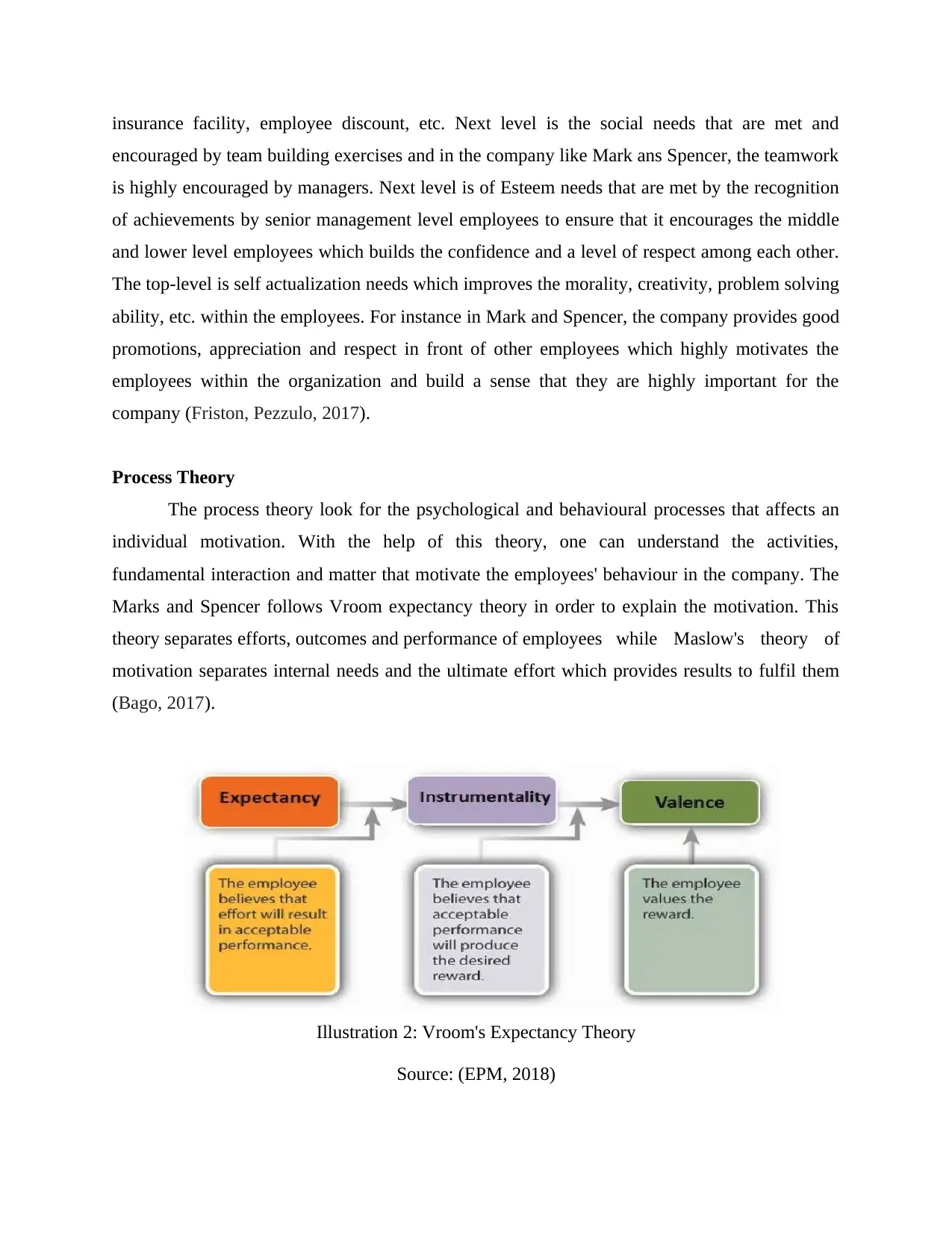
insurance facility, employee discount, etc. Next level is the social needs that are met and
encouraged by team building exercises and in the company like Mark ans Spencer, the teamwork
is highly encouraged by managers. Next level is of Esteem needs that are met by the recognition
of achievements by senior management level employees to ensure that it encourages the middle
and lower level employees which builds the confidence and a level of respect among each other.
The top-level is self actualization needs which improves the morality, creativity, problem solving
ability, etc. within the employees. For instance in Mark and Spencer, the company provides good
promotions, appreciation and respect in front of other employees which highly motivates the
employees within the organization and build a sense that they are highly important for the
company (Friston, Pezzulo, 2017).
Process Theory
The process theory look for the psychological and behavioural processes that affects an
individual motivation. With the help of this theory, one can understand the activities,
fundamental interaction and matter that motivate the employees' behaviour in the company. The
Marks and Spencer follows Vroom expectancy theory in order to explain the motivation. This
theory separates efforts, outcomes and performance of employees while Maslow's theory of
motivation separates internal needs and the ultimate effort which provides results to fulfil them
(Bago, 2017).
Illustration 2: Vroom's Expectancy Theory
Source: (EPM, 2018)
encouraged by team building exercises and in the company like Mark ans Spencer, the teamwork
is highly encouraged by managers. Next level is of Esteem needs that are met by the recognition
of achievements by senior management level employees to ensure that it encourages the middle
and lower level employees which builds the confidence and a level of respect among each other.
The top-level is self actualization needs which improves the morality, creativity, problem solving
ability, etc. within the employees. For instance in Mark and Spencer, the company provides good
promotions, appreciation and respect in front of other employees which highly motivates the
employees within the organization and build a sense that they are highly important for the
company (Friston, Pezzulo, 2017).
Process Theory
The process theory look for the psychological and behavioural processes that affects an
individual motivation. With the help of this theory, one can understand the activities,
fundamental interaction and matter that motivate the employees' behaviour in the company. The
Marks and Spencer follows Vroom expectancy theory in order to explain the motivation. This
theory separates efforts, outcomes and performance of employees while Maslow's theory of
motivation separates internal needs and the ultimate effort which provides results to fulfil them
(Bago, 2017).
Illustration 2: Vroom's Expectancy Theory
Source: (EPM, 2018)
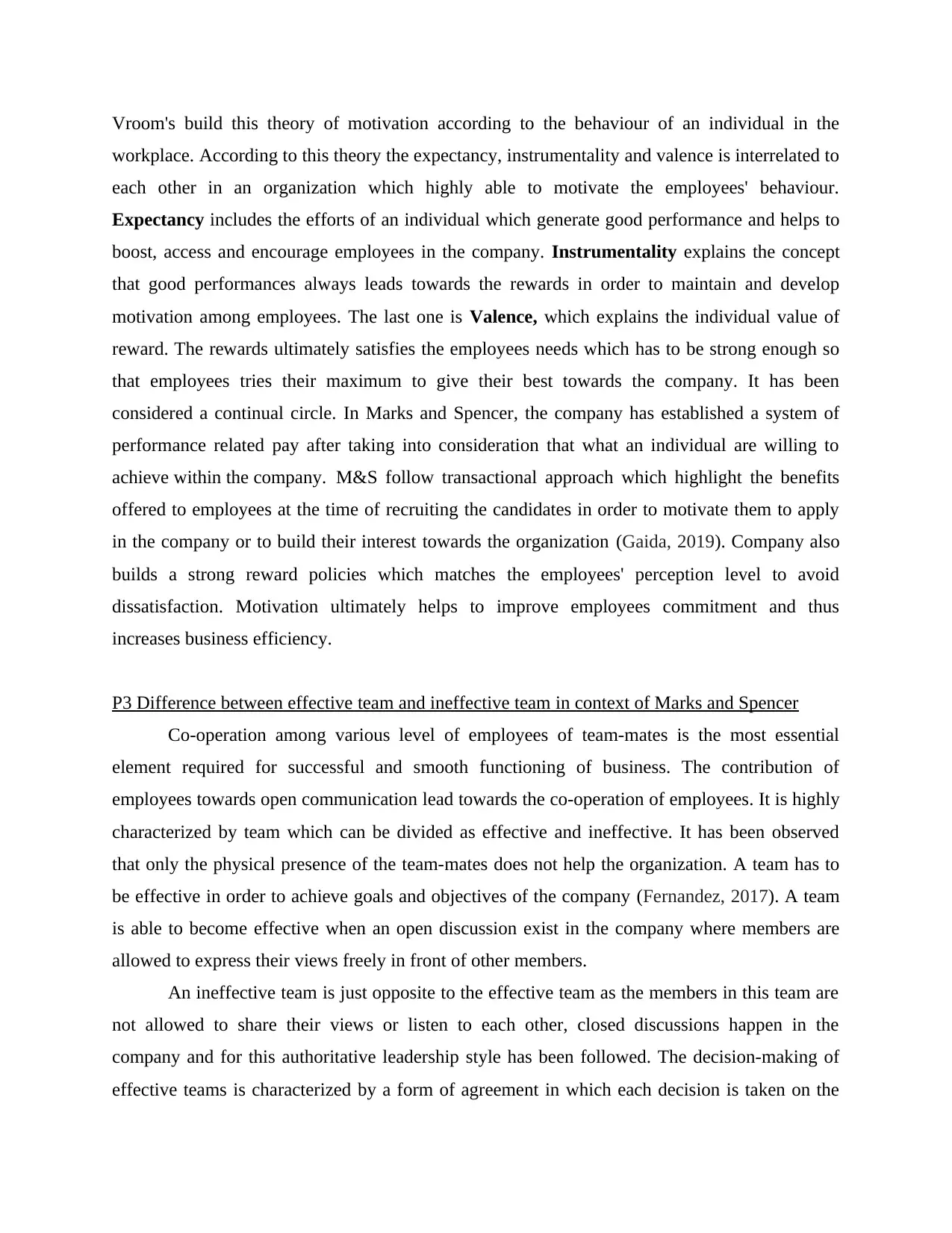
Vroom's build this theory of motivation according to the behaviour of an individual in the
workplace. According to this theory the expectancy, instrumentality and valence is interrelated to
each other in an organization which highly able to motivate the employees' behaviour.
Expectancy includes the efforts of an individual which generate good performance and helps to
boost, access and encourage employees in the company. Instrumentality explains the concept
that good performances always leads towards the rewards in order to maintain and develop
motivation among employees. The last one is Valence, which explains the individual value of
reward. The rewards ultimately satisfies the employees needs which has to be strong enough so
that employees tries their maximum to give their best towards the company. It has been
considered a continual circle. In Marks and Spencer, the company has established a system of
performance related pay after taking into consideration that what an individual are willing to
achieve within the company. M&S follow transactional approach which highlight the benefits
offered to employees at the time of recruiting the candidates in order to motivate them to apply
in the company or to build their interest towards the organization (Gaida, 2019). Company also
builds a strong reward policies which matches the employees' perception level to avoid
dissatisfaction. Motivation ultimately helps to improve employees commitment and thus
increases business efficiency.
P3 Difference between effective team and ineffective team in context of Marks and Spencer
Co-operation among various level of employees of team-mates is the most essential
element required for successful and smooth functioning of business. The contribution of
employees towards open communication lead towards the co-operation of employees. It is highly
characterized by team which can be divided as effective and ineffective. It has been observed
that only the physical presence of the team-mates does not help the organization. A team has to
be effective in order to achieve goals and objectives of the company (Fernandez, 2017). A team
is able to become effective when an open discussion exist in the company where members are
allowed to express their views freely in front of other members.
An ineffective team is just opposite to the effective team as the members in this team are
not allowed to share their views or listen to each other, closed discussions happen in the
company and for this authoritative leadership style has been followed. The decision-making of
effective teams is characterized by a form of agreement in which each decision is taken on the
workplace. According to this theory the expectancy, instrumentality and valence is interrelated to
each other in an organization which highly able to motivate the employees' behaviour.
Expectancy includes the efforts of an individual which generate good performance and helps to
boost, access and encourage employees in the company. Instrumentality explains the concept
that good performances always leads towards the rewards in order to maintain and develop
motivation among employees. The last one is Valence, which explains the individual value of
reward. The rewards ultimately satisfies the employees needs which has to be strong enough so
that employees tries their maximum to give their best towards the company. It has been
considered a continual circle. In Marks and Spencer, the company has established a system of
performance related pay after taking into consideration that what an individual are willing to
achieve within the company. M&S follow transactional approach which highlight the benefits
offered to employees at the time of recruiting the candidates in order to motivate them to apply
in the company or to build their interest towards the organization (Gaida, 2019). Company also
builds a strong reward policies which matches the employees' perception level to avoid
dissatisfaction. Motivation ultimately helps to improve employees commitment and thus
increases business efficiency.
P3 Difference between effective team and ineffective team in context of Marks and Spencer
Co-operation among various level of employees of team-mates is the most essential
element required for successful and smooth functioning of business. The contribution of
employees towards open communication lead towards the co-operation of employees. It is highly
characterized by team which can be divided as effective and ineffective. It has been observed
that only the physical presence of the team-mates does not help the organization. A team has to
be effective in order to achieve goals and objectives of the company (Fernandez, 2017). A team
is able to become effective when an open discussion exist in the company where members are
allowed to express their views freely in front of other members.
An ineffective team is just opposite to the effective team as the members in this team are
not allowed to share their views or listen to each other, closed discussions happen in the
company and for this authoritative leadership style has been followed. The decision-making of
effective teams is characterized by a form of agreement in which each decision is taken on the
⊘ This is a preview!⊘
Do you want full access?
Subscribe today to unlock all pages.

Trusted by 1+ million students worldwide
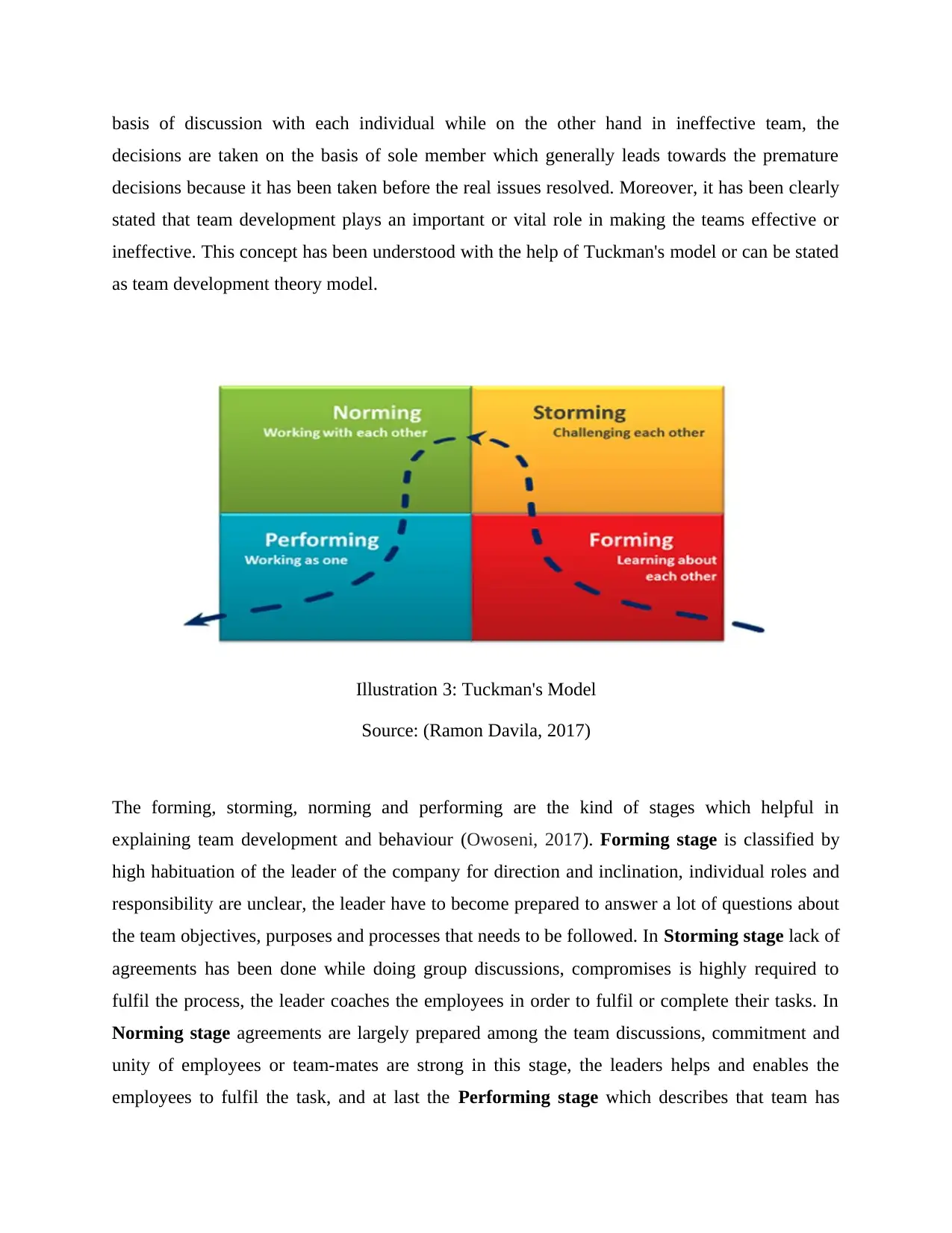
basis of discussion with each individual while on the other hand in ineffective team, the
decisions are taken on the basis of sole member which generally leads towards the premature
decisions because it has been taken before the real issues resolved. Moreover, it has been clearly
stated that team development plays an important or vital role in making the teams effective or
ineffective. This concept has been understood with the help of Tuckman's model or can be stated
as team development theory model.
The forming, storming, norming and performing are the kind of stages which helpful in
explaining team development and behaviour (Owoseni, 2017). Forming stage is classified by
high habituation of the leader of the company for direction and inclination, individual roles and
responsibility are unclear, the leader have to become prepared to answer a lot of questions about
the team objectives, purposes and processes that needs to be followed. In Storming stage lack of
agreements has been done while doing group discussions, compromises is highly required to
fulfil the process, the leader coaches the employees in order to fulfil or complete their tasks. In
Norming stage agreements are largely prepared among the team discussions, commitment and
unity of employees or team-mates are strong in this stage, the leaders helps and enables the
employees to fulfil the task, and at last the Performing stage which describes that team has
Illustration 3: Tuckman's Model
Source: (Ramon Davila, 2017)
decisions are taken on the basis of sole member which generally leads towards the premature
decisions because it has been taken before the real issues resolved. Moreover, it has been clearly
stated that team development plays an important or vital role in making the teams effective or
ineffective. This concept has been understood with the help of Tuckman's model or can be stated
as team development theory model.
The forming, storming, norming and performing are the kind of stages which helpful in
explaining team development and behaviour (Owoseni, 2017). Forming stage is classified by
high habituation of the leader of the company for direction and inclination, individual roles and
responsibility are unclear, the leader have to become prepared to answer a lot of questions about
the team objectives, purposes and processes that needs to be followed. In Storming stage lack of
agreements has been done while doing group discussions, compromises is highly required to
fulfil the process, the leader coaches the employees in order to fulfil or complete their tasks. In
Norming stage agreements are largely prepared among the team discussions, commitment and
unity of employees or team-mates are strong in this stage, the leaders helps and enables the
employees to fulfil the task, and at last the Performing stage which describes that team has
Illustration 3: Tuckman's Model
Source: (Ramon Davila, 2017)
Paraphrase This Document
Need a fresh take? Get an instant paraphrase of this document with our AI Paraphraser
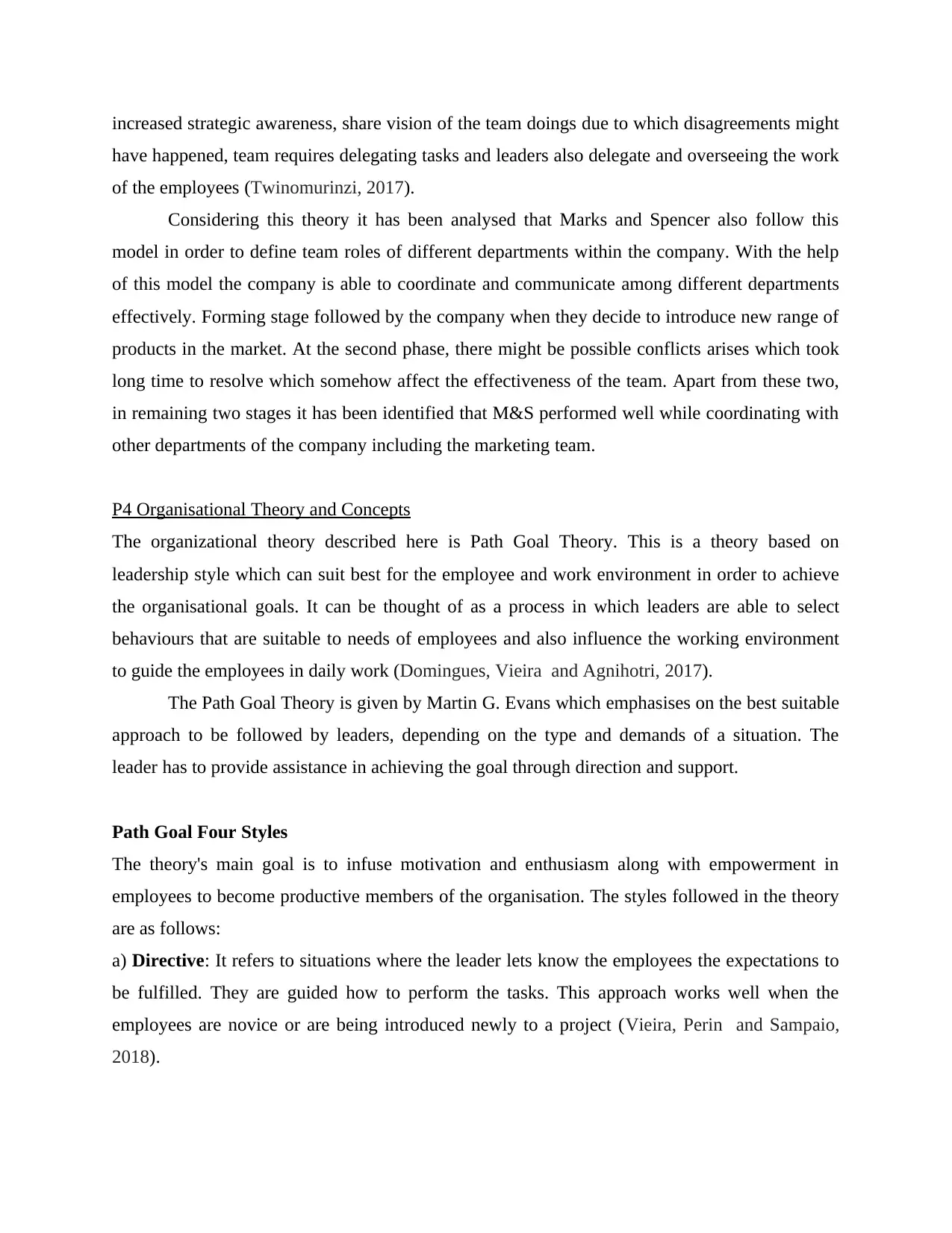
increased strategic awareness, share vision of the team doings due to which disagreements might
have happened, team requires delegating tasks and leaders also delegate and overseeing the work
of the employees (Twinomurinzi, 2017).
Considering this theory it has been analysed that Marks and Spencer also follow this
model in order to define team roles of different departments within the company. With the help
of this model the company is able to coordinate and communicate among different departments
effectively. Forming stage followed by the company when they decide to introduce new range of
products in the market. At the second phase, there might be possible conflicts arises which took
long time to resolve which somehow affect the effectiveness of the team. Apart from these two,
in remaining two stages it has been identified that M&S performed well while coordinating with
other departments of the company including the marketing team.
P4 Organisational Theory and Concepts
The organizational theory described here is Path Goal Theory. This is a theory based on
leadership style which can suit best for the employee and work environment in order to achieve
the organisational goals. It can be thought of as a process in which leaders are able to select
behaviours that are suitable to needs of employees and also influence the working environment
to guide the employees in daily work (Domingues, Vieira and Agnihotri, 2017).
The Path Goal Theory is given by Martin G. Evans which emphasises on the best suitable
approach to be followed by leaders, depending on the type and demands of a situation. The
leader has to provide assistance in achieving the goal through direction and support.
Path Goal Four Styles
The theory's main goal is to infuse motivation and enthusiasm along with empowerment in
employees to become productive members of the organisation. The styles followed in the theory
are as follows:
a) Directive: It refers to situations where the leader lets know the employees the expectations to
be fulfilled. They are guided how to perform the tasks. This approach works well when the
employees are novice or are being introduced newly to a project (Vieira, Perin and Sampaio,
2018).
have happened, team requires delegating tasks and leaders also delegate and overseeing the work
of the employees (Twinomurinzi, 2017).
Considering this theory it has been analysed that Marks and Spencer also follow this
model in order to define team roles of different departments within the company. With the help
of this model the company is able to coordinate and communicate among different departments
effectively. Forming stage followed by the company when they decide to introduce new range of
products in the market. At the second phase, there might be possible conflicts arises which took
long time to resolve which somehow affect the effectiveness of the team. Apart from these two,
in remaining two stages it has been identified that M&S performed well while coordinating with
other departments of the company including the marketing team.
P4 Organisational Theory and Concepts
The organizational theory described here is Path Goal Theory. This is a theory based on
leadership style which can suit best for the employee and work environment in order to achieve
the organisational goals. It can be thought of as a process in which leaders are able to select
behaviours that are suitable to needs of employees and also influence the working environment
to guide the employees in daily work (Domingues, Vieira and Agnihotri, 2017).
The Path Goal Theory is given by Martin G. Evans which emphasises on the best suitable
approach to be followed by leaders, depending on the type and demands of a situation. The
leader has to provide assistance in achieving the goal through direction and support.
Path Goal Four Styles
The theory's main goal is to infuse motivation and enthusiasm along with empowerment in
employees to become productive members of the organisation. The styles followed in the theory
are as follows:
a) Directive: It refers to situations where the leader lets know the employees the expectations to
be fulfilled. They are guided how to perform the tasks. This approach works well when the
employees are novice or are being introduced newly to a project (Vieira, Perin and Sampaio,
2018).
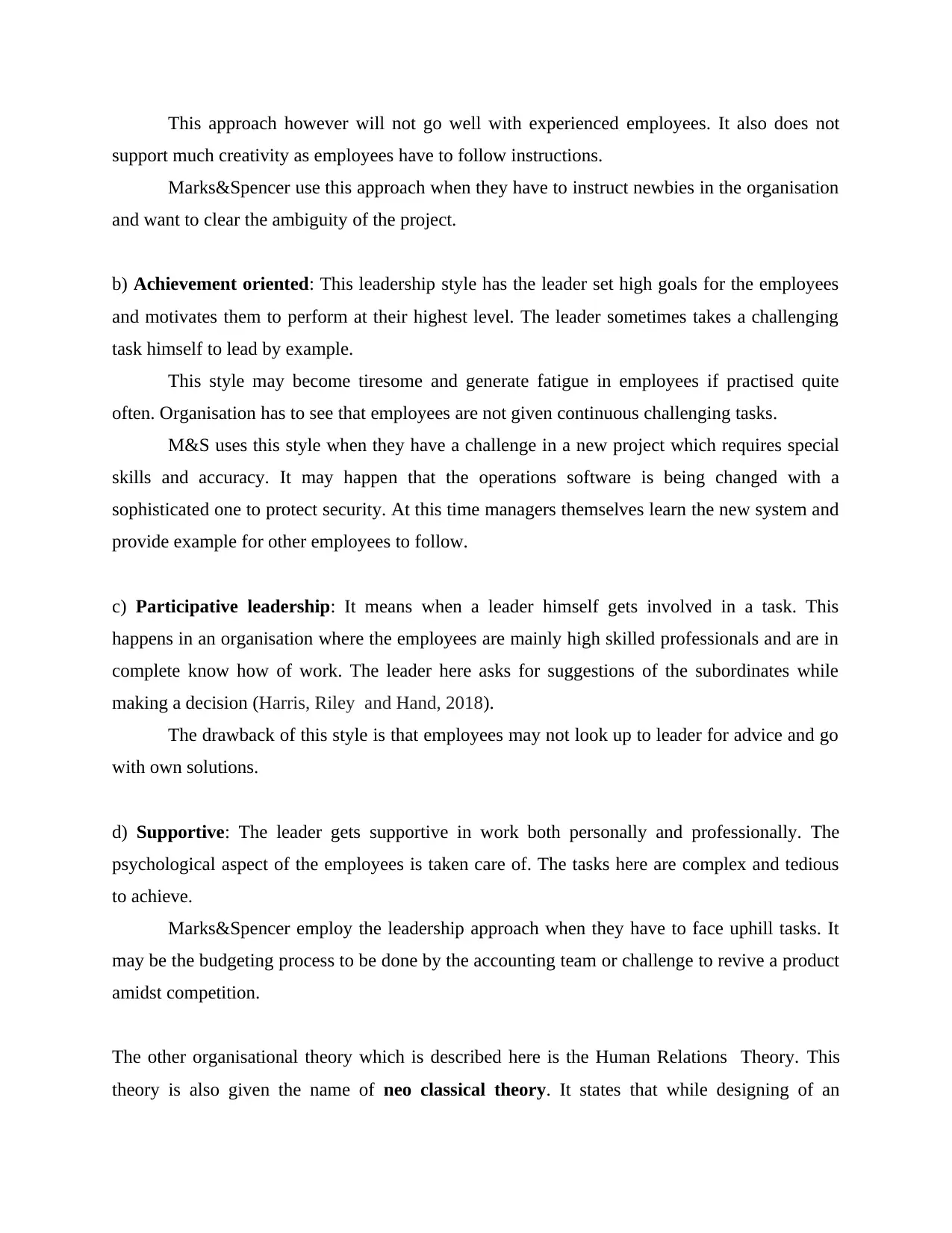
This approach however will not go well with experienced employees. It also does not
support much creativity as employees have to follow instructions.
Marks&Spencer use this approach when they have to instruct newbies in the organisation
and want to clear the ambiguity of the project.
b) Achievement oriented: This leadership style has the leader set high goals for the employees
and motivates them to perform at their highest level. The leader sometimes takes a challenging
task himself to lead by example.
This style may become tiresome and generate fatigue in employees if practised quite
often. Organisation has to see that employees are not given continuous challenging tasks.
M&S uses this style when they have a challenge in a new project which requires special
skills and accuracy. It may happen that the operations software is being changed with a
sophisticated one to protect security. At this time managers themselves learn the new system and
provide example for other employees to follow.
c) Participative leadership: It means when a leader himself gets involved in a task. This
happens in an organisation where the employees are mainly high skilled professionals and are in
complete know how of work. The leader here asks for suggestions of the subordinates while
making a decision (Harris, Riley and Hand, 2018).
The drawback of this style is that employees may not look up to leader for advice and go
with own solutions.
d) Supportive: The leader gets supportive in work both personally and professionally. The
psychological aspect of the employees is taken care of. The tasks here are complex and tedious
to achieve.
Marks&Spencer employ the leadership approach when they have to face uphill tasks. It
may be the budgeting process to be done by the accounting team or challenge to revive a product
amidst competition.
The other organisational theory which is described here is the Human Relations Theory. This
theory is also given the name of neo classical theory. It states that while designing of an
support much creativity as employees have to follow instructions.
Marks&Spencer use this approach when they have to instruct newbies in the organisation
and want to clear the ambiguity of the project.
b) Achievement oriented: This leadership style has the leader set high goals for the employees
and motivates them to perform at their highest level. The leader sometimes takes a challenging
task himself to lead by example.
This style may become tiresome and generate fatigue in employees if practised quite
often. Organisation has to see that employees are not given continuous challenging tasks.
M&S uses this style when they have a challenge in a new project which requires special
skills and accuracy. It may happen that the operations software is being changed with a
sophisticated one to protect security. At this time managers themselves learn the new system and
provide example for other employees to follow.
c) Participative leadership: It means when a leader himself gets involved in a task. This
happens in an organisation where the employees are mainly high skilled professionals and are in
complete know how of work. The leader here asks for suggestions of the subordinates while
making a decision (Harris, Riley and Hand, 2018).
The drawback of this style is that employees may not look up to leader for advice and go
with own solutions.
d) Supportive: The leader gets supportive in work both personally and professionally. The
psychological aspect of the employees is taken care of. The tasks here are complex and tedious
to achieve.
Marks&Spencer employ the leadership approach when they have to face uphill tasks. It
may be the budgeting process to be done by the accounting team or challenge to revive a product
amidst competition.
The other organisational theory which is described here is the Human Relations Theory. This
theory is also given the name of neo classical theory. It states that while designing of an
⊘ This is a preview!⊘
Do you want full access?
Subscribe today to unlock all pages.

Trusted by 1+ million students worldwide
1 out of 16
Related Documents
Your All-in-One AI-Powered Toolkit for Academic Success.
+13062052269
info@desklib.com
Available 24*7 on WhatsApp / Email
![[object Object]](/_next/static/media/star-bottom.7253800d.svg)
Unlock your academic potential
Copyright © 2020–2025 A2Z Services. All Rights Reserved. Developed and managed by ZUCOL.



